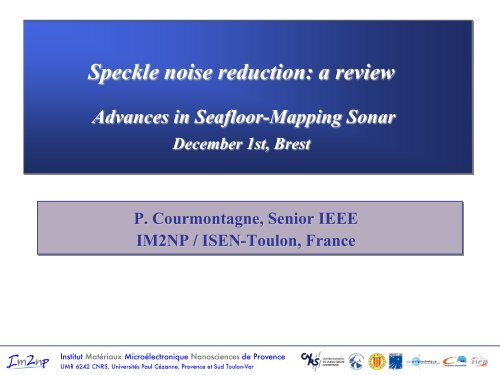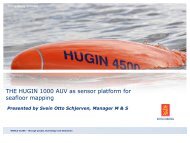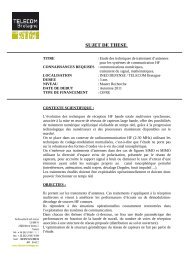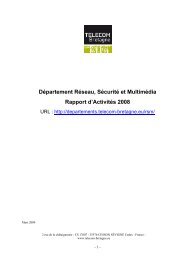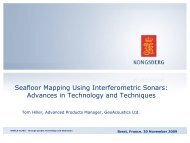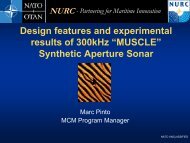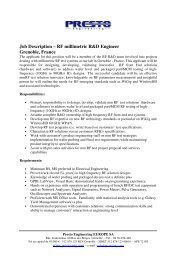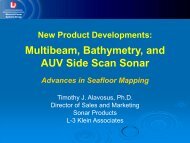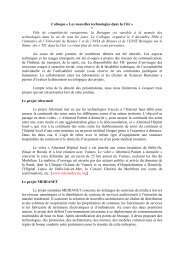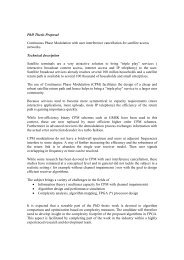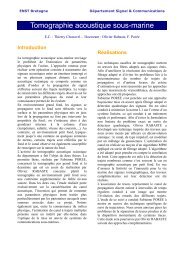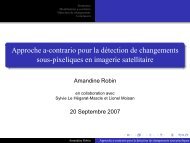Speckle noise reduction
Speckle noise reduction
Speckle noise reduction
Create successful ePaper yourself
Turn your PDF publications into a flip-book with our unique Google optimized e-Paper software.
<strong>Speckle</strong> <strong>noise</strong> <strong>reduction</strong>: a review<br />
Advances in Seafloor-Mapping Sonar<br />
December 1st, Brest<br />
P. Courmontagne, Senior IEEE<br />
IM2NP / ISEN-Toulon, France
<strong>Speckle</strong> <strong>noise</strong> <strong>reduction</strong>: a review – Ph. Courmontagne<br />
2<br />
Synthetic Aperture Sonar<br />
‣ Achieve a good resolution<br />
‣ Drawback: the speckle <strong>noise</strong><br />
Granular <strong>noise</strong> that inherently exists in SAS imagery<br />
By giving a variance to the intensity of each pixel, it reduces<br />
the spatial and radiometric resolutions<br />
Avoids thin interpretation and accurate details perception<br />
<strong>Speckle</strong> <strong>noise</strong> occupies a wider dynamic range than the scene<br />
content itself<br />
Reducing the speckle <strong>noise</strong> enhances radiometric resolution at<br />
the expense of spatial resolution<br />
Compromise speckle <strong>noise</strong> <strong>reduction</strong> / spatial resolution preservation
<strong>Speckle</strong> <strong>noise</strong> <strong>reduction</strong>: a review – Ph. Courmontagne<br />
3<br />
Synthetic Aperture Sonar<br />
‣ Example of SAS data<br />
Data acquisition<br />
SHADOWS© [Jean, 2006]<br />
Sea bed (La Ciotat bay – France)<br />
Resolution: 15 cm<br />
2001 801 pixels<br />
250<br />
200<br />
150<br />
100<br />
50<br />
0<br />
SAS data
<strong>Speckle</strong> <strong>noise</strong> <strong>reduction</strong>: a review – Ph. Courmontagne<br />
4<br />
Filter Assessment methods<br />
‣ <strong>Speckle</strong> Level – Variation Coefficient<br />
Obtained by computing the variation coefficient (C in the<br />
following) for several homogeneous areas of the data.<br />
Let W be the number of homogeneous areas H n , it comes<br />
This one is computed in the same areas before and after process<br />
and allows to compute the <strong>Speckle</strong> Level <strong>reduction</strong><br />
The higher it gets, the better it is
<strong>Speckle</strong> <strong>noise</strong> <strong>reduction</strong>: a review – Ph. Courmontagne<br />
5<br />
Filter Assessment methods<br />
‣ Ratio Image [Walessa, 2000; Achim, 2005]<br />
It corresponds to the ratio of the original image (speckled) by<br />
the de-<strong>noise</strong>d image<br />
In areas of the image where the speckle is fully developed, this<br />
ratio should have the characteristics of pure speckle<br />
Any appearing edge or shape in the ratio image reveals a bad<br />
interpretation of the filter<br />
Several assessment methods are based on the ratio image<br />
Mean value (=1), equivalent number of look (SAR images);<br />
Variation coefficient, mean and speckle <strong>noise</strong> distributions
<strong>Speckle</strong> <strong>noise</strong> <strong>reduction</strong>: a review – Ph. Courmontagne 6<br />
‣ Mean filter<br />
Scalar Filters<br />
Each pixel value is replaced by the average value of its neighborhood in a<br />
M × M window<br />
The result quality is M-dependent<br />
‣ Median Filter [Pitas, 1990]<br />
Each pixel is replaced by the median of all pixels in the neighborhood in a<br />
M × M window<br />
D R D<br />
The result quality is M-dependent<br />
D R D<br />
‣ Hybrid Median Filter [Nieminen, 1986]<br />
Use a 2-way hybrid kernel<br />
<br />
Median values<br />
R R C R R<br />
D R D<br />
D R D<br />
Hybrid kernel, M=5
<strong>Speckle</strong> <strong>noise</strong> <strong>reduction</strong>: a review – Ph. Courmontagne<br />
Scalar Filters: Mean Filter (M = 5)<br />
7<br />
250<br />
200<br />
Computing Time using<br />
a Mean Filter, M=3<br />
250<br />
200<br />
Computing Time T/T 0 1.2<br />
De-<strong>noise</strong>d SAS data<br />
Variance Reduction 9.3<br />
<strong>Speckle</strong> Level Reduction<br />
4.9<br />
FOM<br />
0.62<br />
150<br />
150<br />
Ratio Image<br />
Variation Coefficient Distribution<br />
100<br />
100<br />
Standard Deviation<br />
0.95<br />
0.046<br />
Mean Distribution<br />
50<br />
50<br />
1<br />
Standard Deviation<br />
0.038<br />
De-<strong>noise</strong>d SAS data<br />
0<br />
Ratio Image<br />
0<br />
<strong>Speckle</strong> Noise Distribution<br />
Correlation Factor<br />
108
<strong>Speckle</strong> <strong>noise</strong> <strong>reduction</strong>: a review – Ph. Courmontagne<br />
8<br />
Adaptive Filters<br />
‣ Perform digital signal processing and adapt their<br />
performance based on the input signal<br />
‣ Adaptive filters appear under two forms:<br />
Summation of a weighted noisy data and the mean through the<br />
processed window<br />
performed using a sliding sub-window processing ( p,q and<br />
E{Z p,q } are computed for each window)<br />
Averaging on a part of the pixel values present in the processed<br />
window by the use of masks
<strong>Speckle</strong> <strong>noise</strong> <strong>reduction</strong>: a review – Ph. Courmontagne<br />
9<br />
‣ Henri’s filter<br />
Adaptive Filters – 1 st form<br />
Based on the local estimation of the data and <strong>noise</strong> variances<br />
‣ Lee’s filter [Lee, 1981; Lee, 1986]<br />
Signal estimation by mean square error minimization<br />
mean filter in homogeneous area, noisy data in edge area<br />
‣ Modified Lee filter [Lu, 1996]<br />
Performs a speckle <strong>noise</strong> <strong>reduction</strong> in edge area<br />
‣ Enhanced Lee filter [Lopes, 1990]<br />
The SAS image is divided in 3 classes: homogeneous (mean filter),<br />
heterogeneous (Lee’s filter) and strong heterogeneity (pixel value is<br />
preserved)
<strong>Speckle</strong> <strong>noise</strong> <strong>reduction</strong>: a review – Ph. Courmontagne<br />
10<br />
‣ Kuan filter [Kuan, 1987]<br />
Adaptive Filters – 1 st form<br />
Multiplicative <strong>noise</strong> model transforms into a signal-dependent additive <strong>noise</strong><br />
model + Minimum mean square error criterion<br />
‣ Modified Kuan filter [Lu, 1996]<br />
The Kuan filter derives from a linear approximation (1 st order Taylor<br />
expansion) Modified Kuan: the approximation is extended to 2 nd order<br />
Taylor expansion<br />
‣ Adaptive Frost filter [Frost, 1982]<br />
Equals to Wiener filter adapted to speckle model<br />
‣ Enhanced Frost filter [Lopes, 1990]<br />
Same approach as for the enhanced Lee filter
<strong>Speckle</strong> <strong>noise</strong> <strong>reduction</strong>: a review – Ph. Courmontagne<br />
Adaptive Filters – 1 st form: Enhanced Lee Filter<br />
11<br />
‣ Results (M = 7)<br />
250<br />
200<br />
250<br />
200<br />
Computing Time T/T 0 3.6<br />
De-<strong>noise</strong>d SAS data<br />
Variance Reduction 10.8<br />
<strong>Speckle</strong> Level Reduction<br />
5.9<br />
FOM<br />
0.57<br />
150<br />
150<br />
Ratio Image<br />
Variation Coefficient Distribution<br />
100<br />
100<br />
Standard Deviation<br />
0.92<br />
0.057<br />
Mean Distribution<br />
50<br />
50<br />
1<br />
Standard Deviation<br />
0.040<br />
De-<strong>noise</strong>d SAS data<br />
0<br />
Ratio Image<br />
0<br />
<strong>Speckle</strong> Noise Distribution<br />
Correlation Factor<br />
66
<strong>Speckle</strong> <strong>noise</strong> <strong>reduction</strong>: a review – Ph. Courmontagne<br />
12<br />
Adaptive Filters – 2 nd form<br />
‣ Adaptive mean filter [Pomalaza-Raez, 1984]<br />
Removes from the filtering window the pixels that have a too atypical value<br />
‣ Anisotropic diffusion filter [Perona, 1990]<br />
Diffusion process: the diffusion is isotropic in homogeneous regions and<br />
becomes anisotropic when a gradient is encountered.<br />
‣ Adaptive weighted d filter [Issa, 1996]<br />
It aims to smooth the <strong>noise</strong> and simultaneously enhance edges and preserve<br />
thin structures<br />
‣ Autoadaptive mean filter [Courmontagne, 2007]<br />
Based on the Mean Filter using for each pixel the most adequate window<br />
size, conditioned by the estimated signal first order statistics<br />
‣ Non-local mean filter [Buades, 2005]<br />
Based on the fact that images contain an extensive amount of self-similarities
<strong>Speckle</strong> <strong>noise</strong> <strong>reduction</strong>: a review – Ph. Courmontagne<br />
Adaptive Filters – 2 nd form: Autoadaptive mean filter<br />
13<br />
‣ Results (circular window, M max = 27)<br />
Computing Time T/T 0 20<br />
250<br />
200<br />
250<br />
200<br />
De-<strong>noise</strong>d SAS data<br />
Variance Reduction 14<br />
<strong>Speckle</strong> Level Reduction<br />
12<br />
FOM<br />
0.04<br />
150<br />
150<br />
Ratio Image<br />
Variation Coefficient Distribution<br />
100<br />
100<br />
Standard Deviation<br />
1.07<br />
0.074<br />
Mean Distribution<br />
50<br />
50<br />
1.03<br />
Standard Deviation<br />
0.060<br />
De-<strong>noise</strong>d SAS data<br />
0<br />
Ratio Image<br />
0<br />
<strong>Speckle</strong> Noise Distribution<br />
Correlation Factor<br />
149
<strong>Speckle</strong> <strong>noise</strong> <strong>reduction</strong>: a review – Ph. Courmontagne<br />
14<br />
‣ Principle:<br />
Adaptive Filters in Transform Domain<br />
The idea is to apply different signal decompositions to the SAS<br />
data just followed by a process adapted to the new domain<br />
Two main families of expansion<br />
Discrete Wavelet Transform (Multi-resolution analysis)<br />
Signal expansion in a weighted sum of uncorrelated<br />
random variables, where the basis depends on a priori<br />
knowledge of signal and <strong>noise</strong> statistics
<strong>Speckle</strong> <strong>noise</strong> <strong>reduction</strong>: a review – Ph. Courmontagne<br />
15<br />
Adaptive Filters in Transform Domain<br />
‣ Wavelet expansion & soft or hard thresholding<br />
The SAS data is expanded into several complementary sub-spaces (Mallat<br />
[Mallat, 1989], à Trous [Holdschneider, 1989])<br />
Only a few part of the wavelet coefficients are kept (soft and hard<br />
thresholding [Donoho, 1993])<br />
Only available for a Gaussian disturbing signal Ridgelet [Candes, 1998],<br />
Curvelet [Starck, 2002] and Gaussianisation [Mallet, 2000]<br />
‣ Stochastic Matched Filter (SMF, [Cavassilas, 1991])<br />
SAS data expansion onto a basis enhancing the SNR; signal approximation<br />
reconstruction using only a few part of the decomposition coefficients<br />
Mean square error minimization [Chaillan1, 2005], speckle <strong>noise</strong> local<br />
statistics [Courmontagne, 2007], adaptive [Courmontagne, 2006]<br />
Coupled with multi-resolution analysis: à Trous algorithm [Chaillan, 2006],<br />
Mallat algorithm [Chaillan2, 2005]
<strong>Speckle</strong> <strong>noise</strong> <strong>reduction</strong>: a review – Ph. Courmontagne<br />
Adaptive Filters in Transform Domain: ASMF<br />
16<br />
‣ Results (M max = 27, M min = 3)<br />
Computing Time T/T 0 13<br />
250<br />
200<br />
250<br />
200<br />
De-<strong>noise</strong>d SAS data<br />
Variance Reduction 17<br />
<strong>Speckle</strong> Level Reduction<br />
15<br />
FOM<br />
0.05<br />
150<br />
150<br />
Ratio Image<br />
Variation Coefficient Distribution<br />
100<br />
100<br />
Standard Deviation<br />
0.93<br />
0.062<br />
Mean Distribution<br />
50<br />
50<br />
1<br />
Standard Deviation<br />
0.063<br />
De-<strong>noise</strong>d SAS data<br />
0<br />
Ratio Image<br />
0<br />
<strong>Speckle</strong> Noise Distribution<br />
Correlation Factor<br />
58
<strong>Speckle</strong> <strong>noise</strong> <strong>reduction</strong>: a review – Ph. Courmontagne<br />
17<br />
Maximum A Posteriori (MAP) Filters<br />
‣ Using Bayesian approach, those filters intend to maximize the a<br />
posteriori probability P(S/Z)<br />
‣ Filters’ equations are derived by solving the MAP equation<br />
Assume a non-stationary multiplicative speckle <strong>noise</strong> model<br />
Too small windows introduce a bias<br />
‣ Several approaches depending on the distributions used to<br />
described the signal and P(Z/S)<br />
Kuan MAP filter [Kuan, 1987]<br />
Gamma MAP filter [Lopes, 1993]<br />
Fisher MAP filter [Nicolas, 2003]
<strong>Speckle</strong> <strong>noise</strong> <strong>reduction</strong>: a review – Ph. Courmontagne<br />
MAP Filters: Gamma MAP Filter<br />
18<br />
‣ Results (M = 9)<br />
250<br />
200<br />
250<br />
200<br />
Computing Time T/T 0 3.6<br />
De-<strong>noise</strong>d SAS data<br />
Variance Reduction 13.5<br />
<strong>Speckle</strong> Level Reduction<br />
9<br />
FOM<br />
0.49<br />
150<br />
150<br />
Ratio Image<br />
Variation Coefficient Distribution<br />
100<br />
100<br />
Standard Deviation<br />
0.95<br />
0.036<br />
Mean Distribution<br />
50<br />
50<br />
1<br />
Standard Deviation<br />
0.043<br />
De-<strong>noise</strong>d SAS data<br />
0<br />
Ratio Image<br />
0<br />
<strong>Speckle</strong> Noise Distribution<br />
Correlation Factor<br />
144
<strong>Speckle</strong> <strong>noise</strong> <strong>reduction</strong>: a review – Ph. Courmontagne<br />
19<br />
Conclusion<br />
‣ What is the best de-noising process ?<br />
Quite difficult question<br />
Depends on the use of the despeckled SAS data (detection,<br />
classification, …)<br />
Adaptive filters seem to be a good compromise<br />
‣ Other approaches<br />
Based on the use of filtering process directly on the received<br />
signals before beamforming<br />
Based on a mixing of known de-noising process
<strong>Speckle</strong> <strong>noise</strong> <strong>reduction</strong>: a review – Ph. Courmontagne<br />
20<br />
Bibliography<br />
[Jean, 2006] F. Jean, SHADOWS, by Ixsea, a real-time Synthetic Aperture Sonar system, Electronic Proceedings of OCEANS<br />
2006 - Asia Pacific, Singapore, May 2006.<br />
[Walessa, 2000] M. Walessa and M. Datcu, Model-Based Despeckling and Information Extraction from SAR Images, IEEE<br />
Transactions on Geoscience and Remote Sensing, Vol. 38 (2000), No 5, pp. 2258-2269.<br />
[Achim, 2005] A. Achim, E. Kuruoglu and J. Zerubia, SAR Image Filtering Based on the Heavy-Tailed Rayleigh Model,<br />
Research Report, INRIA, N° 5493, February 2005, FRANCE.<br />
[Pitas, 1990] I. Pitas & A.N. Venetsanopoulos, Nonlinear digital filters, Kluwer Academic Publishers, 1990<br />
[Nieminen, 1986] A. Nieminen, P. Heinonen and Y. Neuvo, 2-D Multilevel FIR-median hybrid filters, Acoustics, Speech and Signal<br />
Processing, IEEE International Conference on ICASSP’86, 11, 1986.<br />
[Lee, 1981]<br />
J.S. Lee, <strong>Speckle</strong> analysis and smoothing of synthetic aperture radar images, Computer graphics and image<br />
processing, n. 17, 1981, pp 24-32<br />
[Lee, 1986] J.S. Lee, <strong>Speckle</strong> suppression and analysis for synthetic aperture radar images, Optical engineering, vol 25 n. 5,<br />
1986, pp 636-643<br />
[Lu, 1996]<br />
Y.H. Lu, S.Y. Tan, T.S. Yeo, W.E. Ng, I. Lim and C.B. Zhang, Adaptive Filtering algorithms for SAR speckle<br />
<strong>reduction</strong>, Geoscience and Remote Sensing Symposium, IGARSS’96, 1 , 1996.<br />
[Lopes, 1990] A. Lopes, R. Touzi, E. Nezry, Adaptive speckle filters and Scene heterogeneity, IEEE Transaction on Geoscience<br />
and Remote Sensing, Vol. 28, No 6, pp. 992-1000, Nov. 1990.<br />
[Lee, 1980]<br />
J.-S. Lee, Digital image enhancement and <strong>noise</strong> filtering by use of local statistics, IEEE Transactions on Pattern<br />
Analysis and Machine Intelligence, PAMI-2, pp. 165-168, 1980.<br />
[Kuan, 1985] D. T. Kuan, A. A. Sawchuk, T. C. Strand, P. Chavel, Adaptative <strong>noise</strong> smoothing filter for images with signaldependent<br />
<strong>noise</strong>, IEEE Transactions on Pattern Analysis and Machine Intelligence, Vol. 7, No 2, pp. 165-177,<br />
March 1985.<br />
[Kuan, 1987] D. T. Kuan, A. A. Sawchuk, T. C. Strand, P. Chavel, Adaptative restoration of images with speckle, IEEE<br />
Transactions Acoustic, Speech, Signal Processing, Vol. 35, No 3, pp. 373-383, March 1987.
<strong>Speckle</strong> <strong>noise</strong> <strong>reduction</strong>: a review – Ph. Courmontagne<br />
21<br />
Bibliography<br />
[Frost, 1982] V.S. Frost, J.A. Stiles, K.S. Shanmugan, J.C. Holtzman, A model for radar images and its application to adaptive<br />
digital filtering of multiplicative <strong>noise</strong>, IEEE Trans. Pattern Analysis and Machine Intelligence, Vol. 4, No 2, pp.<br />
157-166, March 1982.<br />
[Pomalaza-Raez, 1984] C. A. Pomalaza-Raez et C. D. McGillem, An adaptive non linear edge preserving filter, IEEE Trans. on Acoustics<br />
Speech Signal Processing, Vol. 32, No3, pp. 571-576, 1984.<br />
[Perona, 1990] P. Perona and J. Malik, Scale-space and edge detection using anisotropic diffusion, IEEE Trans. On Pattern<br />
Analysis and Machine Intelligence, Vol.12 n.7, 1980, pp 629-639<br />
[Issa, 1996]<br />
I. Issa, Ph. Bolon, Adaptative weighted dalpha filter, Proc. EUSIPCO’96, Trieste, Italy, september 1996, pp.1921-<br />
1924<br />
[Courmontagne, 2007] Ph. Courmontagne, SAS images denoising: the jointly use of an autoadaptive mean filter and the stochastic<br />
matched filter, Electronic Proceedings of OCEANS’07 Aberdeen, June 2007.<br />
[Buades, 2005] A. Buades, B. Coll and J.M. Morel, A non-local algorithm for image denoising, computer Vision and Pattern<br />
Recognition, 2, 60-65, 2005<br />
[Holdschneider, 1989] M. Holdschneider, R. Kronland-Martinet, J. Morlet and P. Tchamitchian, A real time algorithm for the Signal<br />
Analysis with the help of the wavelet transform, in Wavelets. ed. J.M. Combes et al. Springer-Verlag Berlin,<br />
1989, pp.286-297.<br />
[Mallat, 1989] S. Mallat, A Theory for Multiresolution Signal Decomposition: The Wavelet Representation, Proc. IEEE Trans on<br />
Pattern Anal. and Math. intel., Vol. 11 (1989), No 7, pp. 674-693.<br />
[Donoho, 1993] D.L. Donoho and I.M. Johnstone, Adapting to unknown smoothness via wavelet shrinkage, technical report,<br />
Stanford University ([Online] Available: http://www-stat.stanford.edu/_donoho/reports.html), 1993.<br />
[Candes, 1998] E.J. Candes, Ridgelets: Theory and Applications, PhD Thesis, Stanford University, 1998<br />
[Starck, 2002] J.L. Starck, E. Candes, and D.L. Donoho, The Curvelet Transform for Image Denoising, IEEE Transactions on<br />
Image Processing , 11, 6, pp. 670-684, 2002.<br />
[Mallet, 2006] J. Mallet and P. Courmontagne, A new wavelet thresholding approach for SAS images denoising, OCEANS’06,<br />
Boston, September 2006.
<strong>Speckle</strong> <strong>noise</strong> <strong>reduction</strong>: a review – Ph. Courmontagne<br />
22<br />
Bibliography<br />
[Cavassilas, 1991] J.-F. Cavassilas, Stochastic matched filter, Proceedings of the Institute of Acoustics (International Conference on<br />
Sonar Signal Processing), Vol. 13, Part 9, pp. 194-199, 1991.<br />
[Chaillan1, 2005] F. Chaillan, C. Fraschini and Ph. Courmontagne, Stochastic matched filtering method applied to SAS imagery,<br />
OCEANS’05 Europe, Vol. 1, pp. 233-238, Brest, June 2005.<br />
[Courmontagne, 2006] Ph. Courmontagne and F. Chaillan, The Adaptive Stochastic Matched Filter for SAS images denoising,<br />
OCEANS’06, Boston, September 2006.<br />
[Chaillan, 2006] F. Chaillan and P. Courmontagne, Coupling the Stochastic Matched Filter and the à Trous Algorithm for SAS<br />
Images denoising, Electronic Proceedings of OCEANS 2006 - Asia Pacific, Singapore, May 2006.<br />
[Chaillan2, 2005] F. Chaillan, C. Fraschini, M. Amate and P. Courmontagne, Multiresolution Analysis of SAS Images, Proceedings of<br />
OCEANS 2005 - Europe, Vol. 2, pp. 1127-1132, June 2005.<br />
[Lopes, 1993] A. Lopes, E. Nezry, R. Touzi, H. Laur, Structure detection and statistical adaptive speckle filtering in SAR images,<br />
International Journal of Remote Sensing, Vol. 14, No 9, pp. 1735-1758, 1993.<br />
[Nicolas, 2003] J. M. Nicolas, A Fisher-MAP filter for SAR image processing, Proceedings of IGARSS’03, Vol. 3, pp. 1996-1998,<br />
July 2003.


